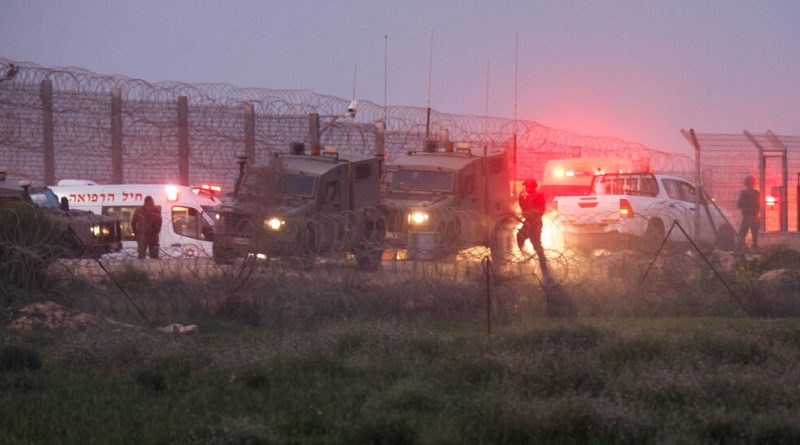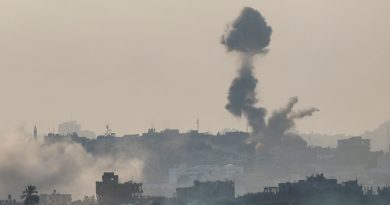Widening Mideast Crisis: E.U. Meeting Highlights Disconnect With Israel Over War Plans

The United States and Britain carried out large-scale military strikes on Monday against eight sites in Yemen controlled by Houthi militants, according to the two countries. The strikes signaled that the Biden administration intends to wage a sustained and, at least for now, open-ended campaign against the Iran-backed group that has disrupted traffic in vital international sea lanes.
The strikes — the eighth in nearly two weeks — hit multiple targets at each site, and were bigger and broader than a recent series of more limited attacks against individual Houthi missiles that the Americans said popped up on short notice. Those missiles were hit before they could be fired at ships in the Red Sea or the Gulf of Aden.
But the planned nighttime strikes on Monday, which hit radars, as well as drone and missile sites and underground weapons storage bunkers, were smaller than the first retaliatory salvos on Jan. 11. Those hit more than 60 targets in nearly 30 sites across Yemen in an expansion of the conflict in the Middle East that the Biden administration had sought to avoid.
This middle ground reflects the administration’s attempt to chip away at the Houthis’ ability to menace merchant ships and military vessels but not hit so hard as to kill large numbers of Houthi fighters and commanders, and potentially unleash even more mayhem into a region already teetering on the edge of a wider war.
“Let us reiterate our warning to Houthi leadership: We will not hesitate to defend lives and the free flow of commerce in one of the world’s most critical waterways in the face of continued threat,” the American and British governments said in a statement.
They were joined in the statement by the Netherlands, Australia, Canada and Bahrain which, as they did in the Jan. 11 strikes, also participated, providing logistics, intelligence and other support, according to U.S. officials.
Taken together, however, the U.S.-led strikes, in an operation the military calls Poseidon Archer, have so far failed to deter the Houthis from attacking shipping lanes to and from the Suez Canal that are critical for global trade. The Iran-backed group says it will keep up its attacks in what it says is a protest against Israel’s military campaign in Gaza against Hamas.
Indeed, the Houthis remained defiant on Monday after the strikes by carrier-based Navy FA-18 fighter jets, Tomahawk cruise missiles and British Typhoon warplanes. “Retaliation against American and British attacks is inevitable, and any new aggression will not go unpunished,” a Houthi military spokesman, Yahya Sarea, said in a statement before the latest American strikes.
The Houthis claimed on Monday to have attacked an American military cargo ship, Ocean Jazz, in the Gulf of Aden, but the White House and Pentagon denied such an assault had happened.
President Biden said on Thursday that U.S. airstrikes against the Houthis would continue. “Are they stopping the Houthis? No,” Mr. Biden said. “Are they going to continue? Yes.”
On Sunday, Jon Finer, a deputy national security adviser, offered a glimpse into the administration’s emerging strategy toward the Houthis forged in several high-level White House meetings in recent days, senior U.S. officials said.
“They have stockpiles of advanced weapons provided to them in many cases, or enabled to them in many cases, by Iran,” Mr. Finer said on ABC News’s “This Week.” “We are taking out these stockpiles so that they will not be able to conduct as many attacks over time. That will take time to play out.”
The American-led air and naval strikes began in response to more than two dozen Houthi drone and missile attacks against commercial shipping in the Red Sea since November. The administration and several allies had repeatedly warned the Houthis of serious consequences if the salvos did not stop.
But two U.S. officials cautioned a few days after the air campaign began that despite hitting more Houthi missile and drone targets with more than 150 precision-guided munitions, the strikes had damaged or destroyed only about 20 to 30 percent of the Houthis’ offensive capability, much of which is mounted on mobile platforms and can be readily moved or hidden.
A third senior official said on Monday that figure may have crept up to 30 to 40 percent after at least 25 to 30 precision-guided munitions successfully hit their targets on Monday. But other U.S. intelligence officials who have been briefed on the size and scope of the Houthis’ arsenal say analysts are not sure how much weaponry the group started with.
American and other Western intelligence agencies have not spent significant time or resources in recent years collecting data on the location of Houthi air defenses, command hubs, munitions depots and storage and production facilities for drones and missiles, the officials said.
That changed quickly after the Hamas attacks in Israel on Oct. 7, and the Houthi attacks on commercial ships a month later. U.S. analysts have been rushing to catalog more potential Houthi targets every day, the officials said. That effort yielded many of the targets hit on Jan. 11 and on Monday, officials said.
Many Republicans in Congress and some former senior U.S. military officials say the approach is not working.
“The key is we have to hurt the Houthis to a degree that they’ll stop,” Gen. Kenneth F. McKenzie Jr., a retired head of the military’s Central Command, said in an interview. “We haven’t done that yet.”
Vivian Nereim contributed reporting from Riyadh, Saudi Arabia.
Source – NY Times




